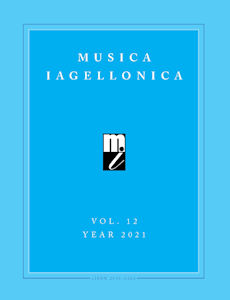Feliks Janiewicz’s violin concertos against the background of the works of his contemporary composers
Feliks Janiewicz’s violin concertos against the background of the works of his contemporary composers
Author(s): Andrzej SitarzSubject(s): Music, 18th Century, 19th Century, History of Art
Published by: Musica Iagellonica Sp. z o.o.
Keywords: Janiewicz Feliks; violin concerto; musical form; 18th-century music;
Summary/Abstract: The works of Janiewicz are characterized by skilful shaping of the form, which can be seen in a clear texture, as well as in tonal and thematic plan of the works. His concertos, and especially their first movements, are a kind of model exemplification of the observations and deliberations of contemporary theorists, for example Heinrich Christoph Koch. The themes of Janiewicz’s works do not go beyond the common formulas then found in the works of his contemporary composers, but many of them testify to the composer’s melodic talent. This applies, for example, to concertos III and IV, and especially the lyricist theme of the concerto V. In each of his concertos, the themes clearly differ from each other, or at least contrast in character in relation to the neighboring figurative fragments. The themes of the second movements are also very attractive. Rondos’ refrains in the third movements are expressive thanks to the simple, symmetrical periodic structure. The shaping of the themes, texture and orchestration of the concertos prove that Janiewicz fully mastered the compositional language of the time. In the first four concertos, the orchestra is a string quartet with a double set of oboes and horns, with a melody in the highest voice (in violino principale, and in tutti fragments in the 1st violin), with the 2nd violin part dependent on the 1st violin, a viola filling the harmony and the cello constituting the basis harmonic. Wind instruments play mainly in tutti parts, and are independent only in small fragments. In concerto V, the composer refers to Viotti’s later concertos, introducing a larger group of wind instruments into the orchestra (additionally a flute and two bassoons), treating the viola more independently and often separating the cellos from double basses. Despite the fact that the instrumentation of the concertos is quite schematic, the composer skilfully uses the performance ensemble, differentiating the volume of sound in emphasizing important fragments of the form and shaping a clear textural structure. In terms of virtuoso technique, Janiewicz’s work does not bring much new to violin literature. The composer uses fairly conventional means (scale figurations, passages, broken thirds, sixths, less often octaves and tenths, or double notes), he rarely uses large jumps, and when appear, they are prepared — or are played on longer rhythmic values.
Journal: Musica Iagellonica
- Issue Year: 12/2021
- Issue No: 1
- Page Range: 57-106
- Page Count: 50
- Language: English

